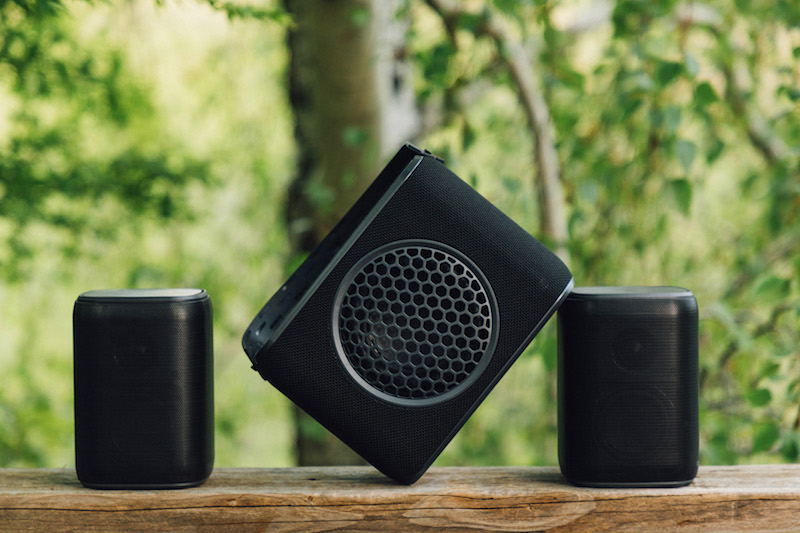Audio speaker placement is a lot like real estate: it’s all about location, location, location.
In real estate, this adage emphasizes how important a safe location is in determining the maximum value of a piece of property. In deciding where to place your speakers, the emphasis is on creating the best listening experience possible.
Far too many people have no idea of how to determine optimal speaker placement, particularly when it comes to the wireless, Bluetooth variety. They may place them too far apart, too close together, at improper angles, wherever they have room, behind obstructions, and dozens of other ways that would make a true audiophile cry.
The good news is that there are some easy-to-follow best practices that average consumers can follow to maximize speaker placement and help deliver the kind of sound quality they expected when they made their purchase. But first, the distinction needs to be made between wireless Bluetooth speakers and traditional “box” speakers.
Ideal for both music aficionados and casual listeners, wireless Bluetooth speakers offer a seamless blend of high-quality audio, aesthetic versatility, and technological convenience that traditional box speakers do not. In the realm of home audio, these speakers — often called “bookshelf speakers” due to their small footprint — can significantly enhance your listening experience when placed correctly in a room, transforming your audio experience from ordinary to extraordinary.
Understanding Acoustics & Speaker Placement
Room Dynamics: The size and shape of a room play a crucial role in acoustics. Sound waves interact with surfaces, and these interactions can either improve or degrade sound quality. An understanding of your room’ acoustics is the first step in optimal speaker placement.
Speaker-Room Interaction: Wireless Bluetooth speakers, while compact, can still significantly impact a room’s sound profile. Placement near hard surfaces like walls and glass can lead to sound reflection, while soft furnishings can absorb it. Balancing these elements is key to achieving clear, undistorted sound.
Two-Speaker Setup
Stereo Imaging: The ability to wirelessly connect multiple speakers is a relatively new concept and one that allows for a stereophonic sound experience. For a two-speaker system, the goal is to achieve a balanced stereo image. The speakers should be positioned to create an equilateral triangle with the listener, ensuring each ear receives a similar audio experience.
Height and Orientation: The speakers’ tweeters should ideally be at ear level in a seated position (which might involve speaker stands or mounts). Speakers should also be angled slightly toward the listener, directing the sound where it’s needed. Tweeters produce the high frequencies, making sound crisper and more detailed when positioned correctly. If speakers are placed too high or too low, the sound bounces off of other surfaces first, which reduces clarity and causes sound to “smear.”
Avoiding Obstructions
Ensure there are no objects directly between the speakers and the listener. Obstructions can block or deflect sound, diminishing the stereo image and sound clarity.
Four-Speaker Setup
Surround Sound Experience: A four-speaker system aims to create an immersive surround sound environment. This setup is often preferred for home theaters but can also enhance music listening.
Front and Rear Speaker Placement: The front speakers should follow the two-speaker setup guidelines. Rear speakers should be placed behind the listener, slightly above ear level if possible, creating an encompassing sound field.
Subwoofer Placement
Two-Speaker System: In a two-speaker setup with a subwoofer, the placement of the subwoofer is less critical due to the non-directional nature of low frequencies. However, experimenting with different spots in the room can optimize bass performance. A common starting point is near the front speakers and located near a wall or hard surface.
Four-Speaker System: With a four-speaker setup, the subwoofer placement remains flexible, but it’s often advantageous to place it closer to the front of the room, aligned with the front speakers. This helps create a more cohesive sound field, integrating the bass more seamlessly with the mid and high frequencies.
Best Practices for Wireless Bluetooth Bookshelf Speakers
Wireless Connectivity Considerations: One of the advantages of wireless Bluetooth speakers is the freedom from traditional wiring constraints. However, it’s important to ensure a stable and strong Bluetooth connection. Avoid placing speakers too far from the Bluetooth source and be mindful of any potential interference that can come from other wireless devices.
Aesthetic Integration: Bookshelf speakers are designed to be both heard and seen. Their placement should not only be acoustically optimal but also aesthetically pleasing and congruent with the room’s decor. This way they will look as good as they sound.
Room-Specific Adjustments
Flexible Positioning: One of the benefits of wireless speakers is the ease of repositioning them. Don’t hesitate to move your speakers around to find the best acoustic and aesthetic balance. You may find a position that doesn’t fall into the best practices bucket but sounds right to your ears.
Listening Position: The ideal listening position is typically at the center of the speaker arrangement, whether it’s a two-speaker stereo setup or a four-speaker surround system. This position ensures that you’ll have a balanced, immersive sound experience.
Subwoofer Nuances in Wireless Systems
Wireless Connectivity: Ensure that the wireless subwoofer maintains a strong connection with the audio source. Like the speakers, it should be strategically placed for both performance and convenience.
Experimentation is Key: Subwoofer placement can significantly affect the overall sound, especially in bass-heavy music. Experiment with different locations in the room, keeping in mind that corners can amplify bass frequencies.
Proper placement of wireless Bluetooth bookshelf speakers and subwoofers is a crucial element in creating an optimal audio experience. Whether you’re setting up a two-speaker system for music enjoyment or a four-speaker surround sound system for immersive experiences, the placement of each component can make a substantial difference in sound quality.
In a two-speaker setup, focus on achieving a clear stereo image by positioning the speakers to form an equilateral triangle with the listening position, ensuring they are at ear level and appropriately angled. In a four-speaker setup, the addition of rear speakers creates an immersive surround sound experience, with careful placement to envelop the listener in audio.
The subwoofer, an essential component in both setups, requires thoughtful placement to enhance the bass without overwhelming the room. In wireless systems, balancing the subwoofer’s location for acoustic impact and Bluetooth connectivity is key. Remember, the non-directional nature of bass frequencies offers more flexibility in positioning the subwoofer, but experimentation is essential to find the optimal spot.
Additionally, the wireless nature of these smaller speakers offers both aesthetic and practical advantages. Their placement should not only consider sound quality but also how they fit into the room’s overall design. The absence of wires allows for cleaner-looking setups and easier adjustments if needed.
Finally, it’s important to remember that every room is unique, and what works in one space may not work in another. The best approach is to start with these best practices and then adjust based on the specific acoustics and layout of your room. Don’t be afraid to experiment with different positions to find the perfect balance of sound quality and room integration.
By following these best practices for speaker and subwoofer placement, you can maximize your listening experience, turning any room into a personal concert hall. And that’s as desirable a location as you can get.








